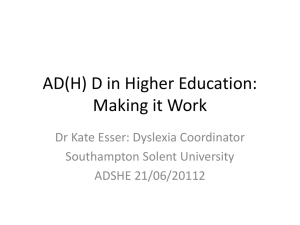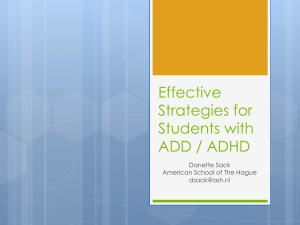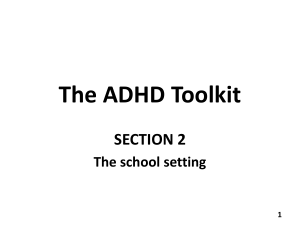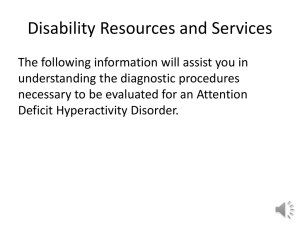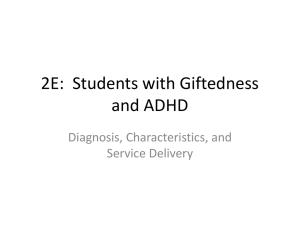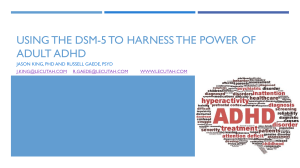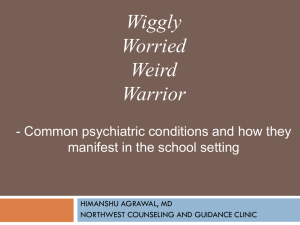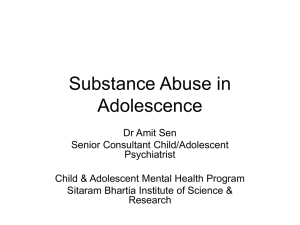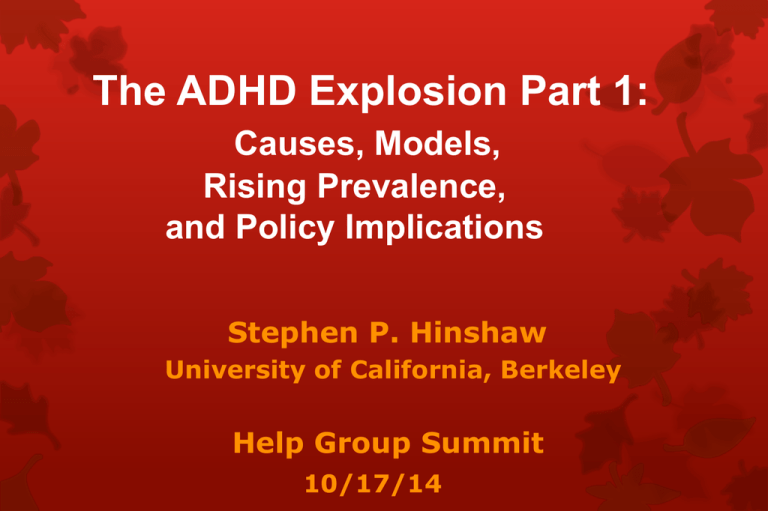
The ADHD Explosion Part 1:
Causes, Models,
Rising Prevalence,
and Policy Implications
Stephen P. Hinshaw
University of California, Berkeley
Help Group Summit
10/17/14
ADHD: Key Themes
Newsworthy
Cause of ADHD is SpongeBob Square Pants
Cause of ADHD is starting kindergarten at age 4
Stimulants lead to heart attacks
New York Times 2012/2013 opinion pieces:
Sroufe, Kureishi, Friedman, Brooks: Back to the past
Too much of the news and opinion is
mythical (see subtitle of book)
4
Facts
ADHD is a neurodevelopmental disorder
with high genetic liability
ADHD incurs huge costs to those with high
levels of symptoms
All too few people with ADHD have
excellent life outcomes—if it’s a gift, in the
words of Ned Hallowell, it’s hard to unwrap
Myths
Medications are poisons, destroying developing brains
Meds help in 80% of cases
May actually be neuroprotective for youth with ADHD
Medication alone is a sufficient treatment
Need family/school intervention for skill building
SEE PART 2 TOMORROW!
ADHD can be assessed and diagnosed in a 10’ office visit
Yet this, far too often, is the national standard
Results in both overdiagnosis and underdiagnosis
Impairment
Academic (school failure)/Vocational
$100 billion/year (youth) indirect costs (justice, sp. ed, SUD)
$200 billion annually (adults) indirect costs (job problems)
Social/peer (most peer-rejected condition)
Family (reciprocal chains of bidirectional influences)
Accidental injury (across the age span)
Impairment often independent of comorbidity…AND key
comorbidities don’t respond optimally to ADHD tx
E.g., LD, delinquency, depression
DSM-5 vs. RDoC
DSM-5 changes:
Neurodevelopmental disorder
Types (Inattentive, HI, Combined) now ‘presentations’
Adult examples of most symptoms
Age of onset of impairing symptoms: < 12 years, not < 7
**Each successive edition of DSM has loosened criteria
somewhat, which is one reason for “ADHD explosion”
Research Domains Criteria
Dimensional, multiple levels (genes to culture)
Search for underlying mechanisms
ADHD Cross Culturally
Appears in nearly all cultures (that feature
compulsory education)
Polanczyk et al. (2007), AJP:
Diagnostic prevalence strikingly similar across world regions: 5%
Disparities linked to dx practices (ICD vs. DSM; informants; etc
Hinshaw et al. (2011)
Within-country variation high in many nations
However, treatments and systems of care vary radically across
regions and cultures
MANY NATIONS ‘CATCHING UP’ WITH U.S. MEDICATION TRENDS
But some not: politics, history, penetration of Big Pharma
Nature of ADHD: Models
“Cognitive” models: Attention deficit, EF
“Inhibitory” models: Barkley (1997)
“Motivation” models: Reward undersensitivity
E.g., Volkow et al. (2009): large medication-naïve adult
sample, PET scans of transporters and receptors
(Motivation)
(Attention)
(Motivation)
(Attention)
Transporter PET Image
(Motivation)
(Attention)
Combination Models
Sonuga-Barke et al. (2010):
Top-down executive control
Bottom-up delay aversion
Time management
ADHD clearly implicates multiple brain
regions and paths for different facets of
symptomatology
Neural profiles
Structural/anatomical:
Overall lowered cerebral volume; caudate, cerebellum…
Key research: Shaw et al. (2006, 2007, 2009, 2012)
Delayed patterns of cortical thickening/thinning in ADHD vs.
comparison samples, longitudinally
Roughly 3 year delay for ADHD groups: Immaturity come to life
Immaturity persists; thickness correlated with symptoms
Functional: Frontal-striatal paths
Until recently: must ‘scan’ during active cognitive performance
Default mode: reliable differences when S’s not ‘doing
anything’; more ‘intrusions’ into task performance in ADHD
ADHD: Causes
Heritability and Genes:
H2 of ADHD near .8
**What is heritability?
‘genetic liability,’ but not inevitability
Too often, assumption is that ADHD is ‘fixed’
and largely immutable
PKU example
Height example
IQ example
Which genes?
Seemed a simple question 10-15 years ago: Genes
related to dopamine systems and pathways in brain
But any single gene variant explains only a tiny
fraction of “ADHD-ness”
‘Dark matter’ of genetics: missing heritability!
Recent discoveries: genes conferring risk for
ADHD are SAME as those conferring risk for
schizophrenia, mood disorders, and autism
MUST BE that early influences are epigenetic
Other Risk Factors
Low birthweight
Predicts ADHD, LD, Tourette’s, CP, retardation
Teratogenic effects
FAE: Many are nearly identical to ADHD symptoms
Smoking/nicotine: genetic mediation, too
Early parenting: No consistent evidence as causal
Middle-class; few prospective studies from early years
Insecure attachment?
Does NOT predict later ADHD, independent of comorbid
aggression
Risk Factors: Equifinality
Carlson et al. (1995):
In low-income sample, early maternal insensitivity
predictive of ADHD symptoms to a greater extent than
early temperament
Need genetically informative design
Institutional deprivation (Kreppner et al., 2001)
English and Romanian Adoptive Study Team:
Inattention/overactivity associated with length of severe
institutional deprivation in first 4 years
Specific effect: Conduct problems and internalizing
symptoms not similarly associated with deprivation
Yet, different “feel” from typical ADHD presentation
AND, EF deficits may be distinct from ‘typical’ ADHD
presentation
Hence, equifinality apparent
Role of Parenting
Maintaining cause, if not primary cause
Parents tend to fight fire with fire
Coercive discipline (too lax, too harsh)
Cycles of dysregulated emotion
Given heritability of ADHD, parents likely to have
ADHD symptoms themselves
Parent management: PART 2, TOMORROW!
Important New Findings
Harold et al. (2013a, 2013b)
Adoption study in UK
Controls for biological relatedness
Even in adoptive families, kids’ levels of ADHD
elicit overcontrolling parenting from parents
AND, levels of harshness predict further ADHD
symptoms, over time
It’s not all in the genes!
Ultimate cause?
The “real” cause of ADHD has to be
compulsory education (same as for LD)
Certainly, ‘attention’ or ‘impulse control’ genes
have been around for the history of our species,
but extremes not salient until we made children
sit and learn to read
If it’s true that achievement pressure “reveals”
ADHD, is it also true that current high rates of
pressure are fueling the recent explosion?
Developmental Paths
Infancy/temperament:
Activity level vs. effortful control
Preschool Manifestations (S. Campbell)
Careful evaluations of 3 and 4 year olds
See AAP Guidelines (2011)
Prospective predictions to mid-late childhood:
PPP = .5! Hence, multifinality apparent
That is, suggestions of (a) “he’ll grow out of it” and (b)
“medicate today” are each fraught with error
Predictors of continuation:
(a) severity of early ADHD
(b) negativity of early parent/child interaction, controlling for
severity of child’s ADHD
Parenting Influences on Positive Peer Status
Hinshaw, Zupan, et al. (1997)
Aim: Predict peer acceptance from parenting
Ideas About Parenting (Heming et al., 1989)
3 factors = Authoritarian, Authoritative, Permissive
Authoritative Factor: 15 items
Warmth, Limits, Autonomy Encouragement--e.g.,
“I
encourage my child to be independent of me”
“I expect a great deal of my child”
“I have clear, definite ideas about childrearing”
“Raising a child is more pleasure than work”
“When I am angry with my child, I let him know”
“I reason with my child regarding misbehavior”
Results
Mothers of ADHD boys: lower on Authoritative
ES = .75
Yet variance in ADHD group equivalent to comparisons
Tested predictive power of parenting factors,
observed overt and covert behavior, and
internalizing score (CDI, observed withdrawal) via
hierarchical regressions
Neither Authoritarian nor Permissive beliefs predicted peer
nominations, but Authoritative beliefs did so (beta = .3),
even with diagnostic group controlled
Explained Variance in Positive Nominations
0.14
0.12
0.1
0.08
0.06
0.04
0.02
0
-Overt
-Covert
-Intern
Mom A-R
Moderation and Implications
Prediction applies only to ADHD group
(beta = .30); for comparisons, beta = .00.
Key theme: “firm yet affirming” parenting
style
Sex Differences/Female Presentation
More in Part 2, tomorrow
Another myth: ADHD effects only boys!
Our sample (BGALS):
Largest in existence of preadolescent girls with ADHD
(140, with 88 matched comparison girls)
Baseline: marked impairments across symptoms,
impairments, neuropsych measures
Impairments maintained at 5-year follow-up
11/11 domains, with widening gap in math
Sources: Hinshaw (2002); Hinshaw et al. (2006), Journal
of Consulting and Clinical Psychology
10-year follow-up
95% retention rate (vs. 92% at 5 year)
How? Facebook, relentless staff
Despite ‘losing’ ADHD status majority of time, impairments
maintain in academics, comorbidities, social functioning.
Yet, self-harm findings: Different adolescent path for girls??
Suicide attempts: 22% ADHD-C
NSSI: 51% ADHD-C 29% ADHD-I
8% ADHD-I
6% comparisons
19% comparisons
BGALS Follow-up: Self-harm
10-year follow-up (M age = 20)
Hinshaw et al. (2012), Journal of Consulting and Clinical Psychology
Conclusions
ADHD not a static “entity”
Different pathways lead to ADHD: Equifinality
Differential outcomes from early ADHD symptoms:
Multifinality
What predicts, moderates, mediates differential outcomes?
Peer deficits and social skills; EF deficits; Motivation
Developmental, contextual factors crucial
Parenting styles, which may not be causal, are important
determinants of outcome, even for a condition with h2 = .7/.8
Systems, health-care, legislative, cultural, stigma-related factors
related to underutilization and disparities in care
Assessment
Full coverage requires a day-long workshop
Brief visit: false positives and false negatives
Must get informant ratings, for kids, teens, or adults
Brief/narrow vs. broader scales
Ideal to get info from past as well as present teacher
Must get full developmental history
Must appraise rule-out and comorbid conditions
LD, Anxiety, Depression, etc. require different interventions
Tidal Wave/ADHD Explosion
National Survey of Children’s Health (Visser et al., 2013)
Parent-reported ADHD ‘ever diagnosed’
For all 4-17 year olds in U.S.:
2003: 7.8%
> 40% INCREASE IN 9 YEARS!
2007: 9.5%
2012: 11.0%
Low income rates now = middle class; Black = White
Hispanic lower (but fast growing)
Medication higher, too:
Just under 70% of those ‘currently diagnosed ‘now receive medication
From other sources: Largest medication increases: adolescents, adults
Earlier Explosions: 1990s
Policy shifts:
IDEA: ADHD as OHI
Medicaid: authorizes ADHD
SSI: ADHD (with other impairment) can qualify
Late 1990s: FDA changes regs on DTC ads
2000: Concerta (first effective long-acting form)
More and more LBW babies survive
Huge Regional Variation Now
Rise across entire nation, but major-league
state-by-state variation, too
2011-12:
Arkansas now #1, Indiana #2, NC #3
NC had been #1 in 2007
Medication trends similar to 2007, but
slightly higher overall
37
38
What does not explain variation
Demographics
Hispanic population clearly higher in California, and
traditionally the lowest rates of diagnosis
Eliminated a little of the CA-NC difference but not most
**Hispanic rates growing FAST, esp. in California
Rates of health-care providers
Explains other disorders, but not here
State “culture”
May explain regional differences within state -- but
not state-by-state per se
**Consequential accountability
1970s-80s: public school reforms “input focused”
Reduce class size, pay teachers more, etc.
Results not consistent; shift in 1990s to “output focused”
I.e., incentivize test score improvements per se
Consequential accountability—districts get ‘noted’ or even
cut off from funds, unless test scores go up
30 states implement such laws <2000
Then, becomes law of the land for all states with No Child
Left Behind (takes effect 2002-3)
Consequential accountability laws prior to NCLB (but
not psychotropic medication laws): In the South
Region
Northeast
Midwest
South
West
United States
Number of
States
9
12
17
13
51
Consequential
Accountability
before NCLB
5
5
15
5
30
Psychotropic
High School Medication
Exit Exam
Law
4
2
3
2
13
5
8
5
28
14
Sources: Investigators' Research, Dee & Jacob 2011, Dee & Jacob 2006, and Center for
41
Education Policy
Findings
From “triple difference” model
Between 2003-2007, in the 20 “NCLB states,”
poorest children showed huge increases in ADHD Dx:
In these states, 59% increase in ADHD dx for kids within
200% of FPL
vs. only 8% in middle- or upper-class kids
Nothing like that in states with previous consequential
accountability (all kids in those states went up 20% or so)
Nothing like that in private schools
This trend reverses by 2012, with Obama’s dismantling of
NCLB
Consequential accountability introduced via NCLB was associated
with higher ADHD diagnostic prevalence increases among lowincome children aged 8-13 from 2003-2007, but there was no
association from 2007-2011 (unadjusted results)
16%
NCLB Consequential
Accountability State,
Income < 200% FPL
Pre-NCLB Consequential
Accountability State,
Income <200% FPL
All Children
15%
14%
13%
12%
11%
10%
9%
8%
2003
2007
2011
Pre-NCLB Consequential
Accountability State,
Income ≥ 200% FPL
NCLB Consequential
Accountability State,
Income ≥ 200% FPL
District of Columbia is included within the 21 No Child Left Behind
consequential accountability states.
NCLB: No Child Left Behind; FPL: Federal poverty level
N=24,982 (2003), 22,467 (2007), 24,426 (2011)
Sources: 2003, 2007, and 2011 National Survey of Children’s Health
“Unintended effect”
Accountability laws encourage ADHD diagnosis for at least
two reasons:
#1: Diagnosis may lead to treatment, which may help boost achievement
test scores
Scheffler et al. (2009), Zoega et al. (2012)
#2: In some states/districts, diagnosed youth are excluded from
the district’s average test score!
Gaming the system, although NCLB eventually outlaws this
Why poorest kids? NCLB targets Title I schools
Psychotropic medication laws
In 2001, Connecticut passed a law ‘pushing back’
against rising ADHD medication use in students
By now, 14 states have passed such “psychotropic medication
laws,” of one or more of 3 types:
Schools are prohibited from recommending meds
Schools cannot require meds as a condition of enrollment
Parental refusal to medicate the child cannot, in and of itself,
be considered neglect
IN THESE STATES, NO RISE IN ADHD DIAGNOSES
FROM 2003-2012, VS. > 50% RISE IN OTHER STATES
46
Findings
In the 14 states with these laws, essentially
no change in ADHD diagnostic prevalence
between 2003 and 2011, versus a > 50%
increase in other states!
Where have we been?
ADHD requires multi-level thinking
Genes matter
Families matter
Cultural values placed on performance matter
Educational policies matter
Pharma matters
ADHD is too important and too impairing to think
about it reductionistically
When kids, learning, schools, productivity, and
medicating young minds are in play, stakes are high
Diversion (Part 2 tomorrow)
Define: non-prescription use
Rates extremely high (why??)
How effective are stimulants as ‘neuroenhancers’
for general population?
Smith & Farah (2011), Psychological Bulletin
Ilieva et al. (2013), Neuropharmacology
Rates of abuse/addiction: Policy implications
Thanks…
NIMH and NIDA grants
Robert Wood Johnson Policy Investigator Award
Participants in many studies
The Help Group
You, the audience

